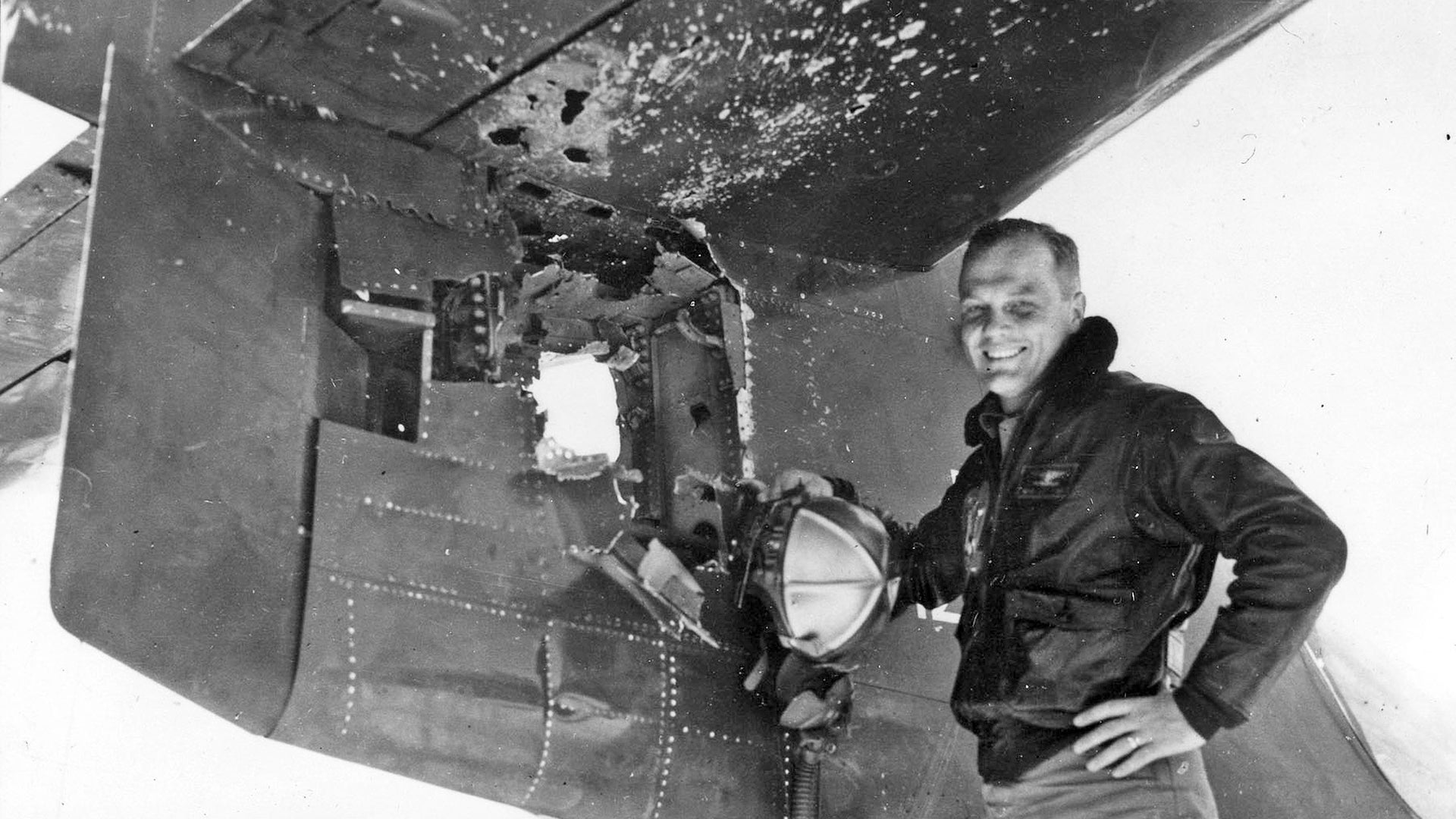Sure, he was the first American to orbit the earth, and he went on to win a Senate seat, but John Glenn was also a down and dirty fighter pilot. He flew F4U Corsairs in the Pacific Theatre during World War II, then went back to war over the skies of Korea in Grumman F9F Panthers. It was during his 63 missions with VMF-311 “Tomcats” over Korea that he gained an off-color but awesomely fitting nickname: “Old Magnet Ass.”
The nickname may sound like a ribbing—it’s anything but. “Old Magnet Ass” came into being as a result of the way Glenn would aggressively pursue ground targets in his Panther. At times he would bravely dive in for attack runs long after the element of surprise had been lost. In the process he would attract so much anti-aircraft artillery fire that his jet would come back riddled with holes.
On one flight near Sinanju, he spotted a North Korean AAA pillbox, though by the time he positively identified the position he would have to circle back to make an attack run. He swooped down and opened up at close range with the Panther’s 20mm cannons, and the North Korean gunners returned the favor with prejudice. Although he nailed the AAA emplacement, his jet was a wreck and nearly uncontrollable, flying far out of trim in the vertical axis.

Amazingly he made it back to K-3 airfield, his home base at the time, and was able to set the plane down in one piece. Upon landing, ground crews were stunned by what they saw. The Panther’s tail had a massive hole blasted in it, nearly large enough to crawl through. Another 250 or so perforations were found on the aircraft. It was amazing that the jet made it back, and Glenn along with it.
In the end, once the Panther had a completely new tail grafted on and the holes were patched the jet returned to action. Glenn swore that it would be the last time he would make a second pass on a target, especially on one whose only mission was to shoot back.
A week later Glenn’s Panther was hit once again, but this time a AAA shell detonated a napalm canister on its wing. Once again, the astronaut-to-be limped the charred and badly damaged airplane back to base and lived to tell about it—though this time there was no saving the aircraft—it was literally burnt to a crisp.

The straight-winged and portly Panther was fairly antiquated from its birth in the ultra-fast evolving jet tech jumble of the 1950s. While it had a reputation as stout ground attack jet that could take a hit, as an air-to-air fighter it was less than sprightly. Glenn missed dogfighting, and after he completed 63 missions with VMF-311 he put in for an exchange slot with the USAF where he would fly America’s new hotrod of the skies—the swept-wing F-86 Sabre—an aircraft that could directly tangle with MiG-15s being flown by the North and its communist allies.

Glenn patrolled the MiG Alley constantly, in the hope of taking on the Soviet-designed jets. Eventually this thirst for air-to-air action got him his second nickname: “The MiG Mad Marine.” Eventually his dogfighting wishes would come true, and he would down three MiGs during his 27 F-86 missions of the Korean War.
For his incredible combat actions in both wars, as well as his more publicized flying feats that came after, Glenn received six Distinguished Flying Crosses—among an avalanche of other medals and awards.

Later the man would go on to become an elite Navy Test Pilot, set a cross-countryspeed record in a an F-8 Crusader, then become the first American to orbit the earth. His accomplishments would continue to stack up long after his historic space mission, becoming a US Senator, then going back into space at the age of 77 aboard the Space Shuttle Discovery as a mission payload specialist. He remains the oldest human to ever fly in space.

Although his death is clearly sad, it’s impossible not to celebrate John Glenn’s amazing life. He is the definition of an American hero, and an inspiration to so many people on so many different levels. When reflecting on the loss of such an amazing American, it brings into focus the stark reality that these heroes from our glorious and gutsy space faring past will one day, in the not too distant future sadly, be gone.
Why don’t we have heroes like this anymore? Or maybe a better question, how can we have heroes like this once again?

They say timing in life is everything, and the heroes of the “Right Stuff” era certainly were in the right place at the right time. They worked excruciatingly hard and took massive risks that few can comprehend. It is hard to argue that America neglected its ability to create environments in which risk takers—explorers and the best among us—can turn become a hero of John Glenn’s level. The sad state of our space program, and a huge aversion to risk in just the places where we need to risk the most can be at least be partially blamed.
In the end maybe John Glenn’s passing will be a stark reminder of what the greatest among us are capable of, when the right medium for fostering massive success is put into place. In the meantime, we can also all admire a special man that became a hero so many times over, and that accomplishing amazing things became the norm not the exception.
I mean you don’t get the name “Old Magnet Ass” for playing it safe right?

Contact the author Tyler@thedrive.com
